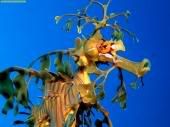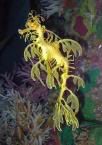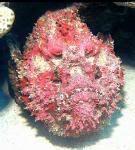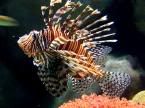

SCIENTIFIC CLASSIFICATION
COMMON NAME: leafy sea dragon
KINGDOM: Animalia
PHYLUM: Chordata
CLASS: Osteichthyes
ORDER: Syngnathiformes
FAMILY: Syngnathidae
GENUS SPECIES: Phycodurus eques
FAST FACTS
DESCRIPTION:
Particularly well camouflaged with elaborate, ornate skin filaments that hang from the head, body and tail making this animal virtually indistinguishable from the floating sea weed in which it lives. Usually green to yellow in color. The body is covered in protective jointed plates instead of scales and long, sharp spines line its dorsal edge.
SIZE: Maximum length 35 cm
WEIGHT: No data
DIET: Mysids and amphipods
INCUBATION: 4-6 weeks
SEXUAL MATURITY: 2 years
LIFE SPAN: 2-3 years in aquaria. Unknown in the wild.
RANGE: South Australia on kelp reefs from 4-30 meters. Western Australia found deeper than 20
meters. Victoria found deeper than 30 meters.
HABITAT: Temperate waters over sand patches among kelp reefs and in protected coastal bays.
POPULATION: GLOBAL Unknown. Very limited baseline info available regarding population
and reproduction rates.
STATUS: IUCN Listed on the IUCN Red List of Threatened Species as Data Deficient
CITES Not listed
USFWS Not listed
REGIONAL Protected in Australia by the following:
Listed as Totally Protected Species in South Australian Waters.
Listed as Protected Aquatic Biota in Victoria.
Listed as Totally Protected fish Status in Western Australian Waters.
Subject to export controls of the Commonwealth Wildlife Protection (Regulations on Exports and Imports) Act of 1982.
FUN FACTS
1. The male sea dragon incubates the fertilized eggs in a specialized spongy textured brood patch on the ventral surface of his tail. This area is composed of small cup-like indentations which each hold a single egg layed there by the female. It is during the transfer of the eggs from the female to the male that they are fertilized. The approximately 250 eggs remain attached until they hatch 4 to 6 weeks later. Sea dragons are completely independent upon hatching. The young feed on the remaining yolk sac and then graduate to consuming zooplankton.
2. Sea dragons do not have any predators. Their combination of excellent camouflage, tough jointed plates and sharp dorsal spines offer adequate protection. Researchers have even observed sea dragons curling up to present predators with the row of menacing spines.
3. For more information about bony fishes, explore the bony fishes info book.
ECOLOGY AND CONSERVATION
Pressure from poaching for aquarium hobbyists, curio seekers and Chinese traditional medicine market. Vulnerable to pollution from run-off and storm damage to kelp reefs. Protected by legislation in Vicoria, South Australia and Western Australia. The "Dragon Search" project managed by Australia's marine and Coastal Community Network records sightings by the public in an effort to monitor the number and size of sea dragon populations.
LIONFISH, SCORPIONFISH, & STONEFISH


SCIENTIFIC CLASSIFICATION
COMMON NAME: lionfish (turkeyfish, zebrafish), scorpionfish, & stonefish (rockfish)
KINGDOM: Animalia
PHYLUM: Chordata
CLASS: Osteichthyes
ORDER: Scorpaeniformes
FAMILY: Scorpaenidae
GENUS SPECIES: No data
FAST FACTS
DESCRIPTION:
A lionfish has a color pattern of contrasting reds and whites and possesses long feathery fins, which hide up to 18 dorsal spines.
Some scorpionfish are also brightly colored and many have venomous dorsal spines.
In contrast, the stonefish, while still possessing highly venomous spines, is named for its rough, rocklike appearance, which helps to camouflage the fish in its rocky habitat.
SIZE: No data
WEIGHT: No data
DIET: Small fishes
INCUBATION: Most oviparous (egg laying); some scorpionfish are viviparous (live birth)
SEXUAL MATURITY: No data
LIFE SPAN: No data
RANGE: Found in all temperate and tropical seas. Most species found in the Pacific and Indian
Oceans.
HABITAT: Found in fresh, brackish and marine waters, but rare in fresh
water.Mostspecies are bottom-dwelling and many inhabit shallow reef areas.
POPULATION: GLOBAL No data
STATUS: IUCN 1 species listed as Critically Endangered,
2 species listed as Endangered, and
1 species as Vulnerable
CITES Not liste
USFWS Not listed
FUN FACTS
1. The huge fish order Scorpaeniformes contains some 20 families and more than 1,000 species. About 300 of these species make up the family Scorpaenidae, which includes scorpionfishes (Scorpaena spp.), stonefishes (Synanceja spp.), and lionfishes (Pterois spp.). All of these fishes have venom glands and spines.
2. The delicate-looking lionfish shows little fear of intruders, for its feathery dorsal fin is well armed. The vivid colors of a lionfish may act as a visual warning to potential enemies to stay away from its deadly spines. To capture prey, it maneuvers small fishes and crustaceans into confined spaces where it can swallow them more easily. When threatened, a lionfish turns its body sideways, delivering a painful jab from its needle-sharp spines. A lionfish can have as many as 18 dorsal spines, some of which can be as long as 36 cm (14 in.). Once injected, the venom causes intensely painful wounds that can lead to convulsions, paralysis, and possibly even death to humans. A lionfish is slow moving for the most part.
3. A stonefish inhabits shallow coral reef areas and the rocky temperate waters of the Indo-Pacific. The camouflage of the stonefish allows it to blend in with the bottom of a reef area, where it waits motionlessly for prey to pass by. It then lashes out with incredible speed, engulfing its prey in one swift motion.
4. Because a stonefish is so well camouflaged, humans may accidentally step on one while wading in shallow water. Stonefish are considered the deadliest fish in the world. There are several recorded human deaths due to stonefish stings.
5. For more information about bony fishes, explore the bony fishes info book.
ECOLOGY AND CONSERVATION
No data
BALLOONFISH


SCIENTIFIC CLASSIFICATION
COMMON NAME: balloonfish
KINGDOM: Animalia
PHYLUM: Chordata
CLASS: Osteichthyes
ORDER: Tetraodontiformes
FAMILY: Diodontidae
GENUS SPECIES: Diodon holocanthus
FAST FACTS
DESCRIPTION: Tan teardrop-shaped body with brown blotches and black spots over entire length. Long spines (typically seen lowered) are found over entire body surface, starting at the forehead. Eyes are large and pronounced with yellow irises. Iridescent blue-green specks may be seen within pupil. Brown band runs over forehead, from eye to eye. Fins are clear. Rounded caudal fin.
SIZE: 20.3-35.6 cm (8-14 in) avg; 50.8 cm (20 in) max
WEIGHT: No data
DIET: Mollusks, crabs, and urchins
INCUBATION: Species exhibits dioecism. Fertilization is external. Spawning primarily occurs
in late spring and early summer.
SEXUAL MATURITY: No data
LIFE SPAN: No data
RANGE: Western Atlantic: Florida to Brazil
Eastern Atlantic: Morocco to Angola and South Africa
Western Indo-Pacific: Micronesia and Australia to Africa
Western Central Pacific: Hawaii, Pitcairn, and Easter islands
Eastern Pacific: southern California to Colombia and the Galapagos
HABITAT: 2-100 meters in tropical & sub-tropical marine coastal waters
POPULATION: GLOBAL No data
STATUS: IUCN Not listed
CITES Not listed
USFWS Not listed
FUN FACTS
1. When threatened or frightened, the balloonfish will take in water - thereby noticeably expanding its overall body size. In this inflated state, its spines stand erect. The spines and the enlarged size can prove intimidating to potential predators.
2. Throughout certain Pacific island communities, the balloonfish was historically fashioned as a helmet.
3. For more information about bony fishes, explore the bony fishes info book.
ECOLOGY AND CONSERVATION
No data







0 comments:
Post a Comment